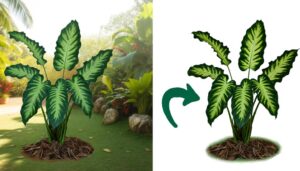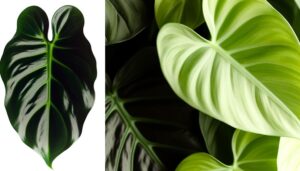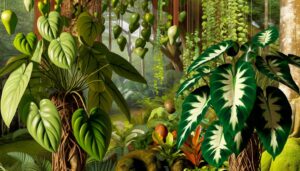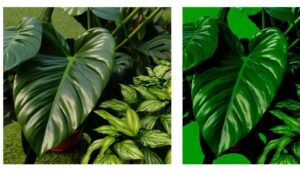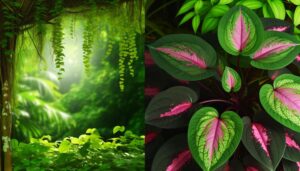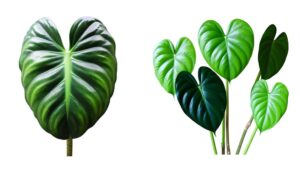Philodendron Glorious Vs Gloriosum: Key Differences!
Philodendron Glorious and Philodendron Gloriosum differ in leaf morphology and growth habits. Glorious features large, glossy, elongated heart-shaped leaves and prefers an upright growth habit.
In contrast, Gloriosum exhibits velvety, wider oval leaves with prominent white veining and adopts a terrestrial, creeping growth pattern. While Glorious is more adaptable to low light conditions, Gloriosum requires higher humidity levels.
Philodendron Glorious demonstrates greater cold resistance, making it more suited for varied environments. Cultivation necessitates indirect light and well-draining soil for both.
Propagation techniques are similar yet nuanced according to plant type. Continue on for deeper insights into their unique cultivation needs.
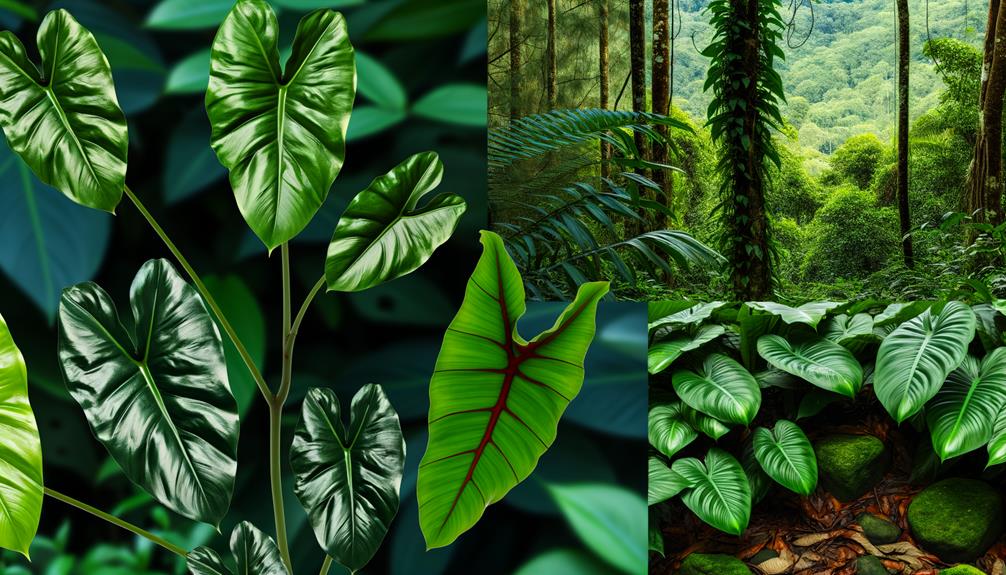
Comparison of Philodendron Glorious and Philodendron Gloriosum
| Feature | Philodendron Glorious | Philodendron Gloriosum |
|---|---|---|
| Common Name | Philodendron Glorious | Philodendron Gloriosum |
| Botanical Name | Hybrid of Philodendron gloriosum and Philodendron melanochrysum | Philodendron gloriosum |
| Leaf Appearance | Dark green, velvety leaves with prominent veins | Large, heart-shaped, velvety leaves with prominent white veins |
| Growth Habit | Climbing vine | Creeping, crawling plant |
| Light Requirements | Bright, indirect light | Bright, indirect light |
| Watering Needs | Moderate, keep the soil slightly moist | Moderate, allow the top inch to dry out |
| Humidity Preference | High humidity | High humidity |
| Temperature Tolerance | 65-80°F (18-27°C) | 65-80°F (18-27°C) |
| Soil Type | Well-draining, aroid mix | Well-draining, aroid mix |
| Fertilization | Monthly during growing season | Monthly during growing season |
| Propagation Methods | Stem cuttings in water or soil | Rhizome division |
| Pest Susceptibility | Spider mites, mealybugs, aphids | Spider mites, mealybugs, aphids |
| Toxicity | Toxic to pets and humans | Toxic to pets and humans |
Origins
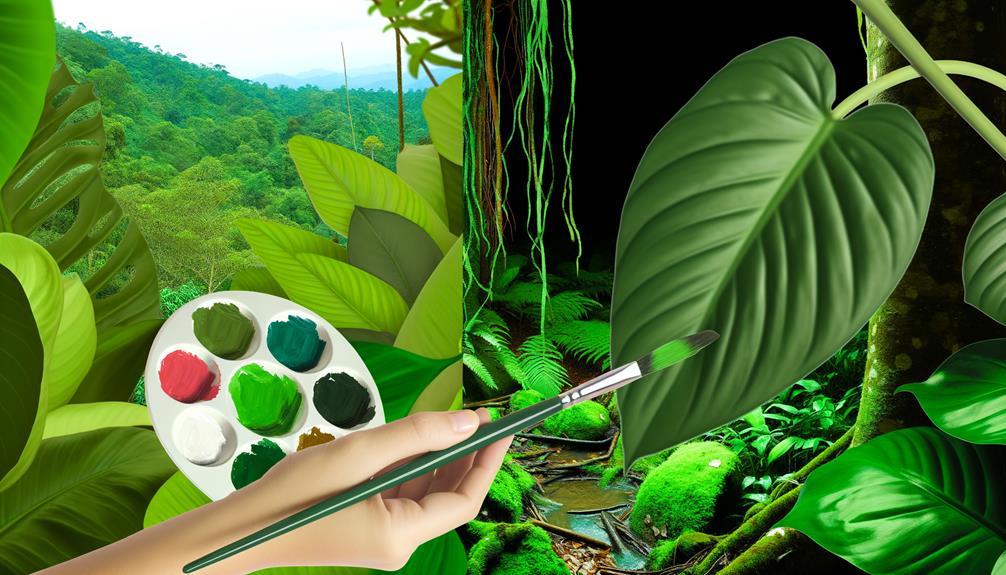
The origins of Philodendron Glorious and Philodendron Gloriosum are rooted in their native habitats within the tropical rainforests of Central and South America, where they have evolved distinct characteristics suited to their environments.
These plants exhibit adaptations such as epiphytic and hemiepiphytic growth forms, enabling them to thrive in high humidity and low light conditions under the forest canopy.
Philodendron Glorious, a hybrid, inherits traits from both its parent species, while Philodendron Gloriosum is a naturally occurring species. The unique climate of their native regions, characterized by consistent rainfall and warm temperatures, provides ideal conditions for their growth.
Cultivation techniques for these species emphasize replicating these environmental parameters, including indirect light, high humidity, and well-draining soil substrates.
Appearance
The appearance of Philodendron Glorious and Philodendron Gloriosum is distinguished by notable differences in leaf morphology, pigmentation, and growth habits.
Philodendron Glorious exhibits elongated, heart-shaped leaves with pronounced veining, while Philodendron Gloriosum features wider, more oval leaves with a velvety texture.
These phenotypic traits, coupled with distinct variegation patterns and growth orientations, are critical for accurate identification and best cultivation practices.
Color Variations
Color variations between Philodendron Glorious and Philodendron Gloriosum exhibit significant differences that are essential for accurate identification and tailored cultivation practices.
Philodendron Glorious, a hybrid, often displays darker, more saturated green hues with occasional red pigmentation on new growth. Conversely, Philodendron Gloriosum features a lighter, velvety green with pronounced white veining, contributing to its distinctive appearance.
Key color distinctions include:
- Leaf Hue: Glorious has deeper green tones, while Gloriosum showcases a lighter, velvety green.
- Veining: Gloriosum’s white veins are more prominent compared to the subtle veining in Glorious.
- New Growth: Glorious may exhibit red tinges in new leaves, unlike Gloriosum.
These differences necessitate specific light and nutrient conditions to maintain the most favorable coloration.
Leaf Shape
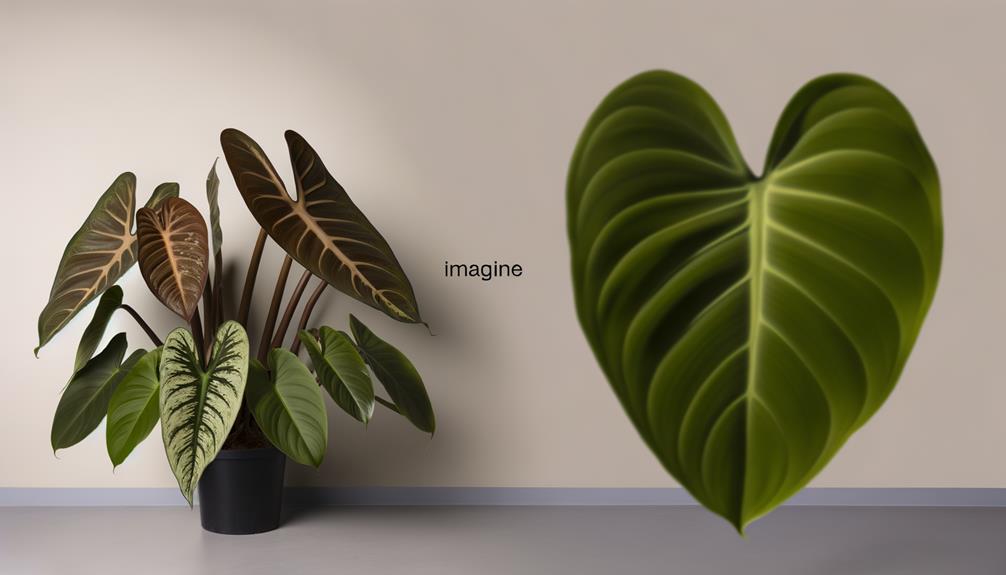
Philodendron Glorious exhibits elongated, heart-shaped leaves with a more pronounced tapering tip, whereas Philodendron Gloriosum’s leaves are broader with a more rounded base and a less acute apex. This distinction in leaf morphology can be attributed to their differing genetic backgrounds and ecological adaptations.
Detailed observations reveal:
- Leaf Venation: Philodendron Glorious features prominent, parallel venation enhancing its slender appearance.
- Leaf Texture: Glorious leaves tend to be more velvety, adding a tactile dimension to their aesthetic appeal.
- Leaf Size: Gloriosum generally produces larger leaves, contributing to its lush, tropical presence.
Cultivation techniques must adjust to these morphological differences, ensuring ideal humidity and light conditions to preserve each plant’s unique leaf characteristics.
Growth Habits
Regarding growth habits, Philodendron Glorious is a hybrid that demonstrates a vining growth pattern, necessitating support structures such as trellises or moss poles to optimize vertical expansion. Conversely, Philodendron Gloriosum exhibits a more terrestrial, creeping growth habit, spreading horizontally across the soil surface.
| Species | Growth Pattern | Support Structure Required |
|---|---|---|
| Philodendron Glorious | Vining | Yes |
| Philodendron Gloriosum | Creeping | No |
Philodendron Glorious benefits from regular pruning to manage its length and promote bushier growth. Moss poles are recommended for this species to emulate its natural climbing behavior.
On the other hand, Philodendron Gloriosum’s horizontal growth demands ample surface area, making it ideal for wide, shallow containers. Both species require periodic repotting to accommodate their growth dynamics.
Light Requirements

Best light conditions for Philodendron Glorious and Philodendron Gloriosum involve indirect, bright light to guarantee healthy foliage development and robust growth.
Both species thrive when exposed to filtered sunlight that mimics their natural understory habitat. Direct sunlight can lead to chlorophyll degradation, causing leaf burn and discoloration.
For ideal light conditions, follow these guidelines:
- Positioning: Place the plants near an east or north-facing window where they can receive consistent, diffused light.
- Artificial Lighting: Utilize fluorescent or LED grow lights for at least 12-14 hours daily if natural light is insufficient.
- Light Intensity: Maintain light levels between 10,000 to 20,000 lux to simulate their native environment, ensuring prime photosynthetic activity without stress.
Watering Needs
Proper watering practices are essential for maintaining the health and vigor of Philodendron Glorious and Philodendron Gloriosum, necessitating a balance between moisture and aeration in the soil.
Both species benefit from consistent watering schedules that prevent the substrate from becoming either waterlogged or excessively dry.
It is advisable to irrigate when the top inch of soil feels dry to the touch. Overwatering can lead to root rot, a common affliction in philodendrons. Employing a well-draining potting medium and ensuring adequate drainage holes in containers helps mitigate this risk.
Monitoring humidity levels, ideally maintaining them between 60-80%, can further enhance hydration without overwatering. Utilizing room-temperature, dechlorinated water also supports ideal absorption and reduces stress on the root system.
Soil Preferences
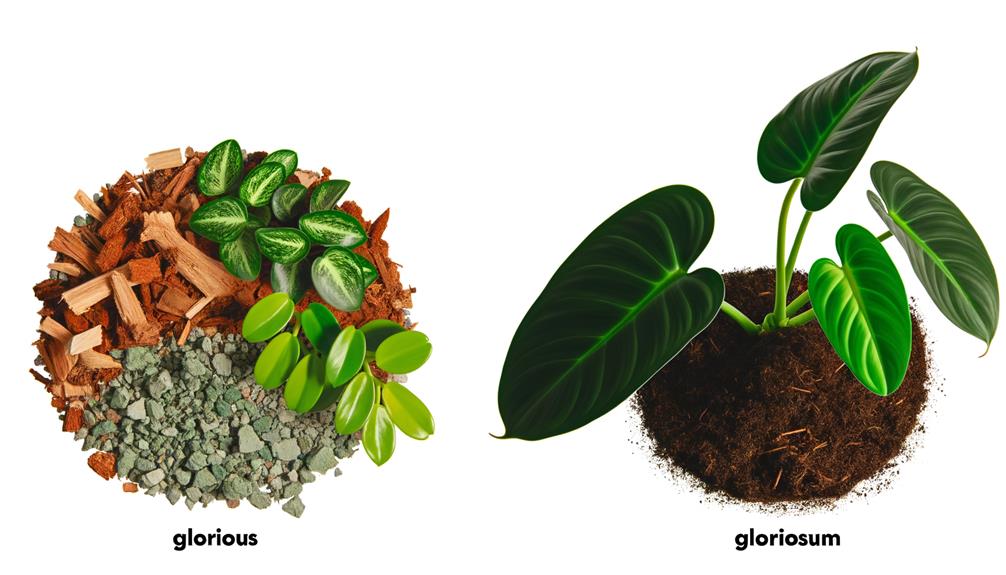
The finest soil composition for Philodendron Glorious and Philodendron Gloriosum is one that ensures both ample drainage and sufficient nutrient retention, thereby complementing their watering needs. Ideal soil should mimic their natural tropical habitat, ensuring root aeration and moisture balance.
To achieve this, consider the following components:
- Aroid Mix: A mixture of orchid bark, perlite, and peat moss offers exceptional drainage and aeration.
- Organic Matter: Integrate compost or worm castings to enrich the soil with essential nutrients.
- Sphagnum Moss: Enhances moisture retention while maintaining a light and airy structure.
These elements collectively provide a favorable environment for healthy root development and robust growth, aligning with the specific botanical requirements of both species.
Temperature Tolerance
Temperature tolerance is an essential factor in the successful cultivation of Philodendron Glorious and Philodendron Gloriosum. Both species thrive in an ideal temperature range between 18°C and 27°C, yet exhibit differential cold tolerance and heat stress resistance.
Specifically, Philodendron Glorious demonstrates a slightly higher resilience to lower temperatures, whereas Philodendron Gloriosum is more vulnerable to heat stress, requiring careful environmental control for best growth.
Optimal Temperature Range
Understanding the best temperature range for Philodendron Glorious and Gloriosum is crucial, as these species thrive best within temperatures between 65°F and 80°F (18°C to 27°C). Maintaining this optimal range guarantees robust growth and minimizes stress-related issues.
Here are key considerations for cultivating these philodendrons:
- Consistent Warmth: Avoid significant temperature fluctuations that can impede growth and induce leaf damage.
- Humidity Correlation: Higher temperatures should be paired with increased humidity levels to replicate their native tropical environments.
- Indoor Cultivation: For indoor growers, position the plants away from cooling vents and drafty windows to uphold stable temperatures.
Adhering to these guidelines will promote healthy development and vibrant foliage, enhancing the overall essentiality of Philodendron Glorious and Gloriosum.
Cold Tolerance Comparison
Philodendron Glorious and Gloriosum exhibit varying degrees of cold tolerance, with both species showing signs of stress below 60°F (15°C).
Philodendron Glorious, a hybrid of Philodendron gloriosum and Philodendron melanochrysum, demonstrates moderate cold resistance but can suffer cellular damage and reduced metabolic function if exposed to prolonged cold.
In contrast, Philodendron Gloriosum, a terrestrial species, exhibits slightly higher resilience to cooler temperatures due to its native habitat conditions.
Cultivators should employ strategies such as utilizing thermal mats and maintaining ambient humidity levels to mitigate cold stress.
Both species benefit from being relocated to warmer indoor environments during colder months to prevent chlorosis and root rot, thereby ensuring the best growth and health.
Heat Stress Resistance
Adaptability to elevated temperatures is important for the most growth and survival of both Philodendron Glorious and Gloriosum, as both species can experience physiological stress when exposed to prolonged heat.
Heat stress can lead to reduced photosynthetic efficiency and impaired cellular functions. Effective management practices are essential for cultivating these philodendrons in warmer climates.
- Shading and Humidity Control: Utilize shade cloth to mitigate direct sunlight and maintain ideal humidity levels around 60-80%.
- Watering Strategies: Increase watering frequency during high-temperature periods to prevent dehydration and maintain turgor pressure.
- Soil Composition: Employ well-aerated, moisture-retentive substrates to support root health and prevent thermal stress.
These techniques optimize both species maintain vigor and resist heat-induced stress.
Humidity Levels
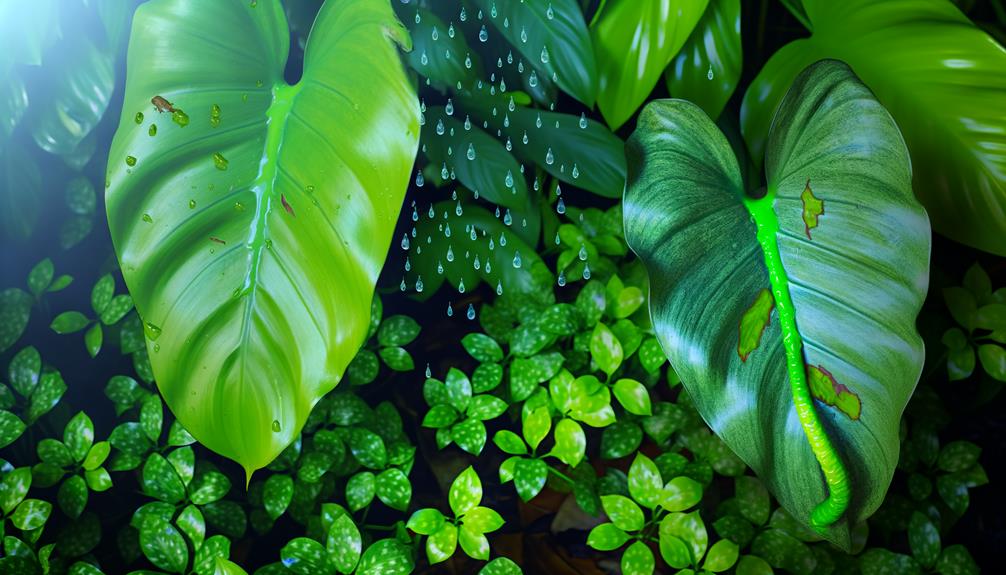
Maintaining perfect moisture levels is crucial for the healthy growth of both Philodendron Glorious and Gloriosum, as these tropical plants thrive in environments with high moisture content. Ideal moisture ranges between 60% and 80%, reflecting their native habitats.
Low moisture can lead to desiccation and browning of leaf edges, while excessive moisture may foster fungal infections. To achieve and maintain these levels, employ humidifiers, pebble trays, or regular misting.
In enclosed spaces such as greenhouses or indoor areas, ensuring adequate air circulation is crucial to prevent stagnant, overly moist conditions. Hygrometers can be utilized to monitor ambient moisture accurately.
Recognizing and adjusting to these specific moisture requirements promotes robust foliage and overall plant health.
Propagation
Propagation of both Glorious and Gloriosum species can be effectively achieved through stem cuttings, guaranteeing each segment contains at least one node and a healthy leaf. This method promotes robust root development and successful establishment of new plants.
To optimize propagation, follow these steps:
- Cutting Selection: Choose a healthy stem with visible nodes and vibrant foliage.
- Medium Preparation: Use a well-draining, sterile substrate such as a mix of perlite and peat moss.
- Environment Control: Maintain high humidity and indirect light to facilitate root growth.
Regularly monitor the cuttings for signs of rooting and growth, typically observable within 2-4 weeks. Properly executed propagation guarantees vigorous new plants, maintaining the genetic integrity and aesthetic appeal of these Philodendron species.
Pest and Disease Resistance
Philodendron Glorious and Gloriosum exhibit varying degrees of resistance to common pests such as spider mites, aphids, and mealybugs, with Gloriosum often being more susceptible to infestations. Disease susceptibility also differs, with Gloriosum showing a higher predisposition to fungal infections like root rot under suboptimal conditions.
Effective prevention and treatment strategies, including proper watering techniques and the use of systemic insecticides, are essential for maintaining plant health.
Common Pest Challenges
Both Philodendron Glorious and Philodendron Gloriosum exhibit varying degrees of susceptibility to common pests such as spider mites, aphids, and mealybugs, requiring attentive monitoring and proactive management strategies to maintain their peak health.
These pests can cause significant damage by sucking plant sap, leading to stunted growth and reduced robustness.
To mitigate these challenges, consider the following practices:
- Regular Inspection: Conduct routine examinations of foliage for early detection of infestations.
- Biological Controls: Introduce beneficial insects like ladybugs and predatory mites to curb pest populations.
- Chemical Interventions: Employ insecticidal soaps or neem oil as targeted treatments for severe infestations.
Adhering to these cultivation techniques promotes strong pest management, fostering healthier Philodendron specimens.
Disease Susceptibility Differences
While effective pest management is essential, understanding the disease susceptibility differences between Philodendron Glorious and Philodendron Gloriosum is equally vital for ensuring optimal plant health.
Philodendron Glorious, a hybrid, exhibits a moderate resistance to common fungal pathogens such as Pythium and Phytophthora due to its hybrid vigor.
Conversely, Philodendron Gloriosum, being a species plant, tends to be more prone to bacterial leaf spot caused by Xanthomonas. Observations indicate that Gloriosum is more susceptible to root rot in poorly-drained substrates.
Cultivation techniques should, therefore, emphasize well-aerated, fast-draining soils and vigilant watering practices. Both plants benefit from regular inspection for early disease symptoms, which can greatly enhance their overall health and longevity in cultivation.
Prevention and Treatment Tips
Regularly examining the foliage and root systems for early signs of infestation or disease can greatly reduce the impact of pests and pathogens on both Philodendron Glorious and Philodendron Gloriosum.
Employing integrated pest management (IPM) strategies and maintaining ideal growing conditions are essential.
- Cultural Control: Maintain proper ventilation and humidity levels to prevent fungal infections. Remove any decaying plant material promptly to minimize breeding grounds for pests.
- Mechanical Control: Manually eliminate visible pests such as aphids, spider mites, and scale insects using a damp cloth or a gentle stream of water.
- Chemical Control: Use organic insecticidal soaps or neem oil as a last resort, applying them carefully to avoid phytotoxicity and ensuring thorough coverage of affected areas.
These steps can greatly improve plant resilience.
Philodendron Gloriosum X Melanochrysum
The Philodendron Gloriosum x Melanochrysum is a hybrid that combines the best traits of both parent plants.
Appearance:
- Leaves: Large, velvety, heart-shaped leaves with a dark green hue and prominent, light-colored veins. The hybrid combines the velvety texture of Gloriosum with the elongated shape of Melanochrysum.
- Growth Habit: Typically a climbing plant, displaying a combination of the creeping nature of Gloriosum and the climbing habit of Melanochrysum.
Care:
- Light: Prefers bright, indirect light. Too much direct sunlight can scorch the leaves.
- Water: Keep the soil consistently moist but not waterlogged. Allow the top inch of soil to dry out between waterings.
- Humidity: Thrives in high humidity environments. Regular misting or a humidifier can help maintain the needed moisture.
- Soil: Well-draining, aerated soil is essential. A mix of peat, perlite, and orchid bark works well.
This hybrid is prized for its stunning foliage and unique combination of characteristics from its parent plants, making it a favorite among collectors.
Conclusion
In the intricate dance of botanical nuances, the Philodendron Glorious and Philodendron Gloriosum reveal their distinct identities through origins, morphology, and growth patterns. Light preferences, temperature tolerances, and humidity demands further delineate their unique cultivation needs.
Yet, one question lingers, tantalizingly unresolved: which of these verdant marvels will ultimately reign supreme in the horticulturist’s collection? The answer, cloaked in the subtleties of nature and nurture, remains an enigmatic allure for plant enthusiasts and scholars alike.

